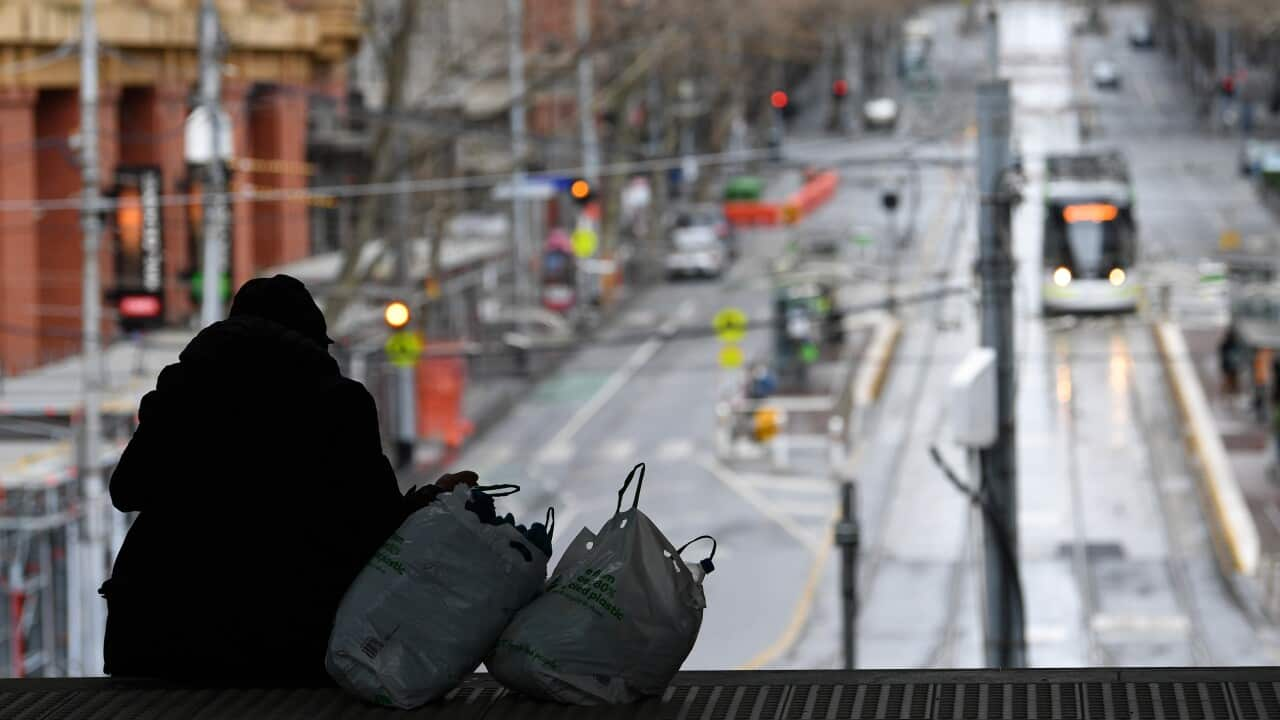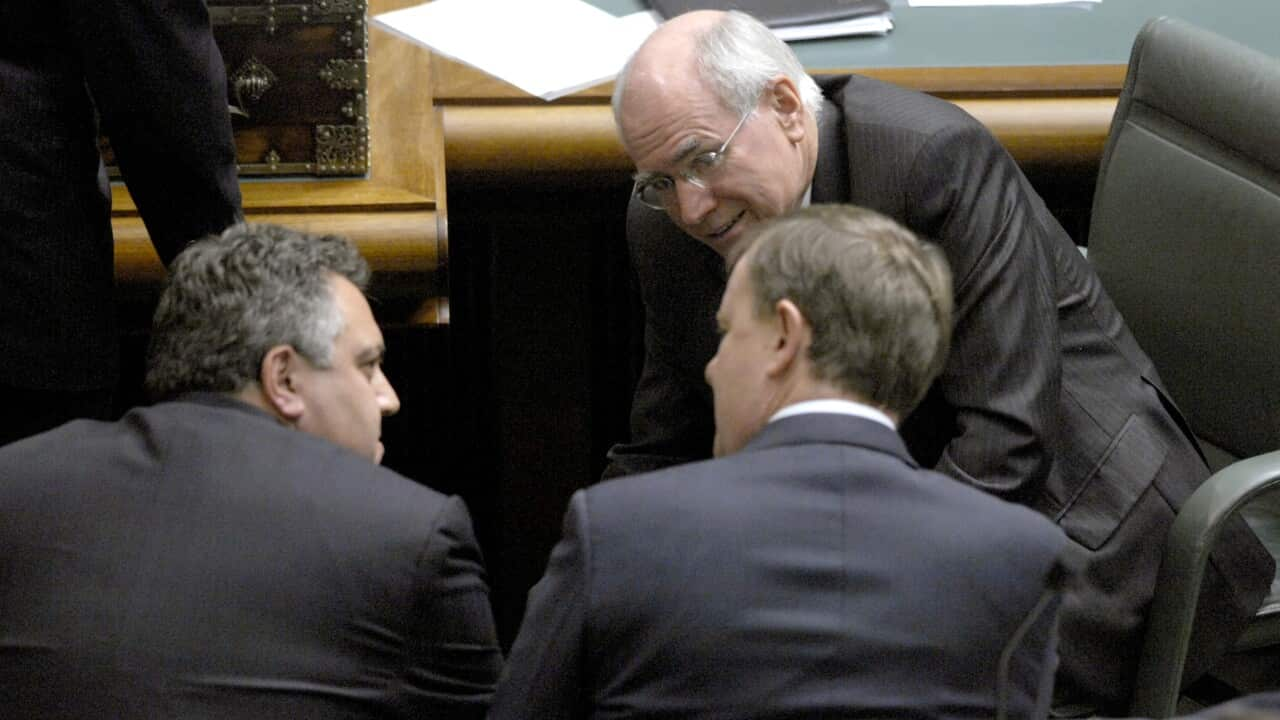On a quiet residential street in central Helsinki, Finland, sits an eight-storey apartment complex. It’s modern, well-designed and akin to the sort of block you'd find in any Australian city.
The complex features a spacious courtyard with communal gardens and a small basketball court, balconies with large glass windows, plus a conveniently located cafe and bar right next door.
It also boasts two unusual design features: instrument storage and practice rooms where residents can play music together.
This is Jallukka, a block of affordable rental houses built to serve people who have struggled to find housing in the private market.

The Jallukka apartment block looks one you'd see in any of Australia's cities. Source: SBS News / Kathleen Farmilo
The 74 apartments that make up Jallukka are divided into two wings: one with 49 regular flats, run by the Y-Foundation, and another with 25 reserved for music workers, run by ELMU.
The basement includes rooms for instrument storage and is set up with sound mixers, microphones and amps.
Jallukka was conceived in part to address the acute housing challenges faced by music workers, explains Maria Degerman, a special adviser at the Y-Foundation.
"The reason we want to build this kind of building is because many musicians have low incomes, and they want to make art [for] the people," she says.

One of Jallukka's rehearsal rooms, with a drum kit and amps. Source: SBS News / Kathleen Farmilo
"You need some kind of space where you can practise your singing or playing."
A project like Jallukka is possible in part because of the Finnish government's approach to equitable and affordable housing. But could a similar project ever work in Australia?
Finland's Housing First model
In the last 30 years, Finland has drastically reduced homelessness by implementing a set of policies called Housing First, which are based on the principle that everyone is entitled to a place to live.
In practice, it means that homeless people are offered homes unconditionally, rather than having to meet certain requirements, such as finding employment, before accessing housing.
The Y-Foundation is one of the organisations that builds affordable rental housing under the Housing First scheme.
It funds projects with a mix of government support and rent from tenants.
According to Degerman, an essential element of Housing First is encouraging homeless people to set their own goals, rather than having goals imposed on them by a social worker.
Everyone needs to have a place to be and live. And when you have that place, then you can build your life.Maria Degerman, Y-Foundation
Dr Cameron Parsell is a professor of social science and an Australian Research Council industry fellow at the University of Queensland and describes Finland's approach to housing as "purposeful".
"Finland has a very clear plan that all citizens, as a right of citizenship, should have housing, and it's the state's responsibility to create the conditions for those citizens to have access to that housing," he tells SBS News.
According to the Housing Finance and Development Centre of Finland, the homelessness rate in Finland has decreased by about 80 per cent since the 1980s.

A row of mics and — of course — a Jimi Hendrix poster in one of Jallukka's rehearsal spaces. Source: SBS News / Kathleen Farmilo
Australia's housing crisis
With concurrent housing and rental crises in Australia, some experts say Finland's Housing First approach could be part of the solution.
Rising rents have out of their homes in recent years — even those on above-average incomes.
As of June 2023, there were around 446,000 social housing dwellings in Australia, according to the Australian Institute of Health and Welfare.
The most common type of social housing is public, followed by community housing. Social housing also includes state-owned and managed Indigenous housing and Indigenous community housing.
Dr Liam Davies, a lecturer in sustainability and planning at Melbourne's RMIT University, says that in Australia, there are significantly lower amounts of social housing than in many Nordic countries, such as Finland.
"The problem is that any form of social housing in Australia needs funding, and at the moment, funding hasn't been provided at a level sufficient to sustain the system, let alone grow it," he says.
According to Parsell, Australia could afford to invest in affordable housing projects, such as Jallukka, but it would also require a shift in social attitudes.
"Australia has the wealth to invest in far more forms of social [and] affordable housing. The reason we don't is because we choose differently," Parsell says.
"As a society collectively, we need to decide that that's what we want to do, and for the most part, many, many Australians do not want to do that.
"They don't do that because they benefit from the commodified forms of housing, or we see homeownership as the norm that our society should be structured around."
Social housing for artists
Australia's dual housing and cost of living crises have been a particular strain on the nation's creative workers, who are typically low-income.
A Creative Australia and Macquarie University survey released in May 2024 found that in the 2021-2022 financial year, professional artists earned an average income of $54,500.
Only $23,200 of that was derived from their creative work.
For rent to be considered "affordable", it should be no more than 30 per cent of a person's income.
According to the Rental Affordability calculator, someone earning $54,500 a year could afford to pay $313.56 per week in rent.
But Domain's shows the median cost of renting a house in all capital cities is well above that figure.
For example, the median rent for a house in Sydney is $775, which is more than double, while a unit is $720.

Source: SBS News
In Sydney, one council program is aiming to tackle inner-city housing insecurity for artists.
The initial idea for the City of Sydney's 'creative live and work spaces' was proposed at a 2011 Council meeting, and since then has housed around 70 artists.
Among them is Jeff McCann, a visual artist and illustrator who works primarily with cardboard.
In 2018, McCann was living in a share house with three other people, working out of their bedroom.
"I remember that I had a king single bed because I told myself I couldn't afford to have a double bed and take up more space," McCann tells SBS News.
"I was spending every morning turning my bed up against the wall and working for the day on stuff, and then at nighttime putting my mattress down."
I just knew it wasn't a healthy thing for me to be doing.Jeff McCann, artist
McCann had applied for one of the creative live and work spaces three times previously, and his fourth application was successful.
McCann says having a dedicated creative space is "critical" for their work.
"For a lot of my early career, I focused on 'creative Jeff' … and the other elements kind of got left behind for a bit.
"I realised a lot of changes in the way that I approached the business side of things. I actually had the physical space to shut a door and to go, 'Okay, I'm not thinking about what I can make within my three by three bedroom.'"

Visual artist Jeff McCann lived in one of the City of Sydney's creative live and work spaces. Source: SBS News / Kathleen Farmilo
Sydney's creative live and work spaces
Currently, the City of Sydney has seven creative spaces, which are leased for around 18 months at a time. Most are in a building in Darlinghurst, with one in Waterloo.
As the name suggests, the idea is that artists can both live and work in them.
"We know artists find it tough to secure affordable inner-city housing and workspaces as soaring costs push artists out of central Sydney," says Sydney's lord mayor Clover Moore.
Our research shows an alarming number of spaces where creatives once made and exhibited work in the last decade have been lost to a booming residential property market.Sydney lord mayor Clover Moore
The spaces are available to artists from a broad spectrum of practices, including design, literature, performing arts, visual arts and craft, and are priced "well below market rent", says Moore.
The City of Sydney has also recently released its 10-year cultural strategy, committing an extra $20 million in "direct support" to artists, producers and creative spaces.
Subsidised housing that is designed specifically for creative workers, such as Sydney’s creative live and work spaces or Helsinki's Jallukka, is a vital part of addressing housing affordability overall, says Parsell.
"It means that people are able to be safe, people are able to live healthfully, and people are able to pursue their careers with excellence in a way that they're unable to do if they're living in unaffordable, insecure housing," he says.
"Of course, the artistic endeavours that these people progress enhance the fabric of society. They benefit us all."
Could Australia have its own Jallukka?
While there are some small-scale housing initiatives and residencies available to Australian artists, there are none currently at the scale of Jallukka.
Outside of the City of Sydney’s spaces, Parsell says he isn't aware of any similar programs funded or organised through different levels of government.
"I just think it's an example of 'it can happen'.
It's not necessarily complex, it's just we need to make the decision that we want to engage in these kinds of housing forms for certain sections of the population, for example, people in the arts.Cameron Parsell
McCann believes a hybrid live-and-work housing model like Jallukka could work well in Australia.
"I would love to see something like that, multiple things like that all over, in all different spaces … What I could pull from a coastal kind of living is different to the bush, which is different to the city."
But for such a project to come to life, Davies says planning should not be at "the whim of the market".
"If we leave housing up to market forces, you only get those that can afford it and you lose that diversity," he says.
While markets are "part of the solution", he says the crucial factor is government investment.
"Governments need to actually become more interventionist in deciding what outcomes they want and then implementing policies to achieve those outcomes."
As well as government intervention, Parsell says the key is "ensuring that the population's brought along as well".
"The government is pursuing these housing means or these housing policies because that's what the voting population want.
"So it's about society understanding that access to affordable housing is going to benefit them by creating enhanced social cohesion, solidarity, and also equity within society."






